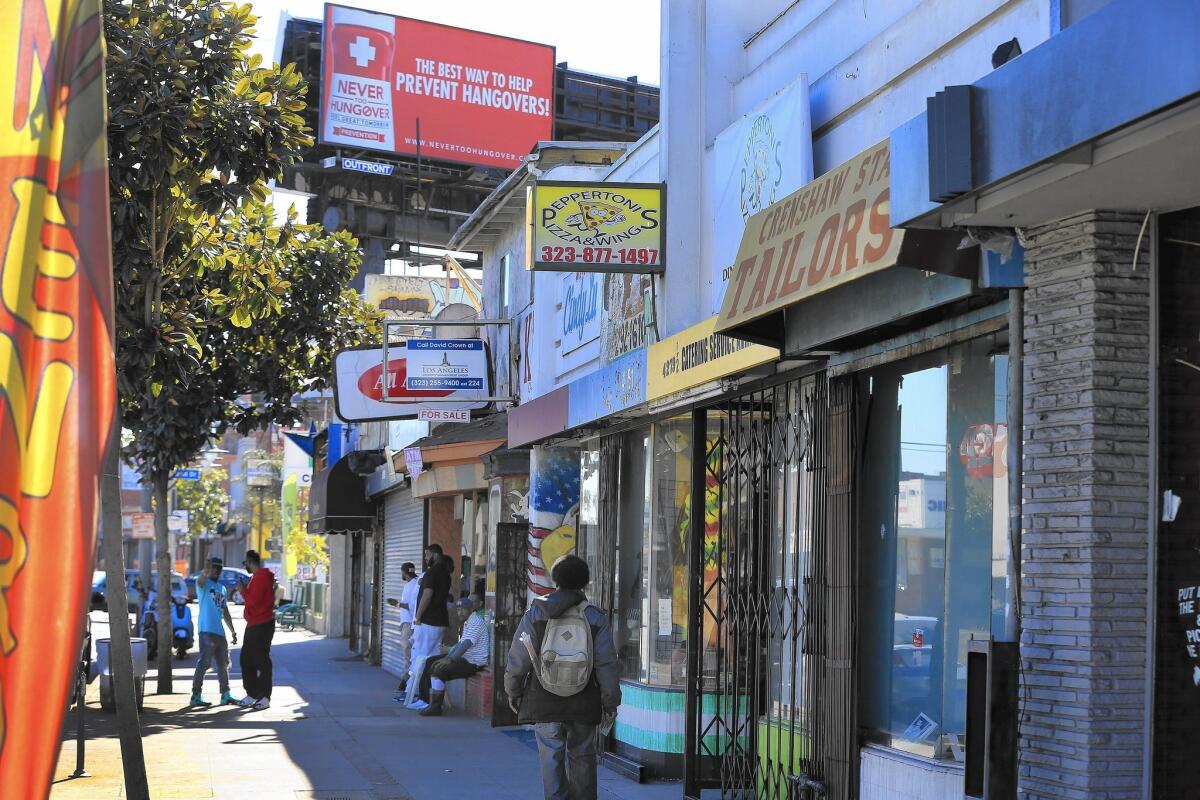Could a mall in Baldwin Hills become the next Glendale Americana?

- Share via
Perched high atop a parade float on Martin Luther King Jr. Day, Yvonne Ellett surveyed Crenshaw Boulevard, the once-vibrant retail spine of South Los Angeles.
She was disappointed by what she saw: tattoo parlors, marijuana dispensaries and boarded-up businesses.
“Our retail corridors make us look like we are poverty-stricken,” said Ellett, co-chairwoman of the Empowerment Congress West Area Neighborhood Development Council. “That’s not necessarily the case. These are solid middle-class neighborhoods.”
The economic renaissances that have roared into neighborhoods like downtown Los Angeles, Highland Park and Venice have largely skipped over the south side of the city.
Now, there’s a grand vision to revive Crenshaw Boulevard, a stretch high in symbolism especially for L.A.’s black community. The plan is to transform the Baldwin Hills Crenshaw Plaza into an “urban village” that would mirror Glendale’s Americana, with a 12-story hotel, office space, new shops, restaurants, condominiums and apartments.
Several projects are in the pipeline that could drive demand for more retail and restaurants. Kaiser Permanente is slated to open a medical center at nearby Marlton Square next spring. A subway station will open in 2019.
But last month the mall’s biggest draw, Wal-Mart, closed its doors, possibly complicating developers’ efforts to attract future tenants.
“The biggest question is ‘What replaces it, if anything?’” said Clint Rosemond, who helps convene the Leimert Park Village and Crenshaw Corridor Stakeholders Group. “We have a void now.”
Over the years, Crenshaw Plaza has experienced peaks and valleys. Most recently, it has struggled to gain a loyal following among more affluent residents living in Baldwin Hills, who prefer to drive to Culver City’s Westfield Mall, the Third Street Promenade in Santa Monica or Beverly Hills for upscale shopping.
There is a feeling that much is riding on being able to morph the Crenshaw mall into a broader shopping destination — and that if such a plan were to succeed it could revitalize the entire Crenshaw corridor from West Adams to Leimert Park.
“The mall, if you look at the tenanting plan, is very successful in recent years in pulling in national retailers, which is why their plan for making it the hub of the Crenshaw corridor is viable,” said Carolyn Hull of the Los Angeles County Economic Development Corp. “The mall has brought in high-quality sit-down restaurants. They created a little food corridor over there with Chipotle,” Buffalo Wild Wings and IHOP.
Thirteen years ago when Wal-Mart opened the store at the mall it was seen as a savior after another large retailer suddenly left, leaving a hole.
“Wal-Mart cannot complain about going broke there,” L.A. County Supervisor Mark Ridley-Thomas said. “Traffic was significant enough. You can’t sustain a 400-person workforce without the revenues to do so. I think they made a business decision, and now we’re on to the next iteration of economic development in the Baldwin Hills Crenshaw Plaza.”
Developer and mall owner Capri Capital Partners has spent more than $35 million in major upgrades. Part of Capri’s mission, former partner Ken Lombard told The Times in 2010, is to “crack the code and show others how they can be successful in a diverse minority community.”
City officials have long struggled to convince retailers they should come south of the 10 Freeway.
Capri has tried to woo retailers with tours of well-to-do neighborhoods of View Park, Baldwin Hills and Ladera Heights. It has taken maintenance and security teams on field trips to the Grove to show them the caliber expected at the Baldwin Hills Crenshaw Plaza.
From its beginnings in 1988, the Baldwin Hills Crenshaw Plaza was an experiment in urban planning. It was a pioneering inner-city shopping mall that was created with the idea that older minority communities could be revived by offering goods and services that residents previously had to travel miles to find.
Sitting on the corner of Martin Luther King Jr. and Crenshaw boulevards, the mall has worked to become an extension of the community by putting on free concerts and fitness classes. It hosts a weekly farmers market, and the annual Pan African Film and Arts Festival draws thousands from across L.A.
Wal-Mart’s closure surprised residents and the mall owner. Capri told a neighborhood group that it was negotiating a new lease with Wal-Mart when the chain announced on a Friday that it would close the Crenshaw location two days later.
The three-level Wal-Mart was an anchor tenant that drew a steady stream of shoppers to the mall. It was also the largest retailer in an underserved community with scant options.
“Wal-Mart really serviced a lot of people in a lot of different ways,” said Ellett, the community activist. “We lost a fabric store, an art supply store, a pharmacy and fresh food and small appliance store.”
And 395 people, in a community with one of the highest unemployment rates in the county, lost their jobs.
Capri Capital declined to comment on how the closure of Wal-Mart could affect the mall’s future.
Wal-Mart’s exit is not “an indictment of the community” or project, Hull said. It speaks more to changing retail trends around the country.
Fewer people are shopping at malls as more are turning to online shopping. Major retailers, including Macy’s, Kmart and Wal-Mart — announced plans to downsize after a weak holiday season.
See more of our top stories on Facebook >>
At a community meeting inside the Vision Theater last month, residents expressed concerns that Wal-Mart’s departure could signal the flight of other retailers. But many remained cautiously optimistic.
Kay Benjamin, 65, of Baldwin Hills has pinned her hopes on the $2-billion Crenshaw-to-LAX light rail, believing it could bring a return of retailers to the neighborhood.
“I’m just waiting for the train to come,” she said.
Twitter: @AngelJennings
ALSO
Grim Sleeper serial killer trial to begin, years after slayings terrorized South L.A.
After the San Bernardino shootings, a SWAT doctor reflects on lessons learned
Proposal would shift bullet train funding for use on new water projects
More to Read
Sign up for Essential California
The most important California stories and recommendations in your inbox every morning.
You may occasionally receive promotional content from the Los Angeles Times.











